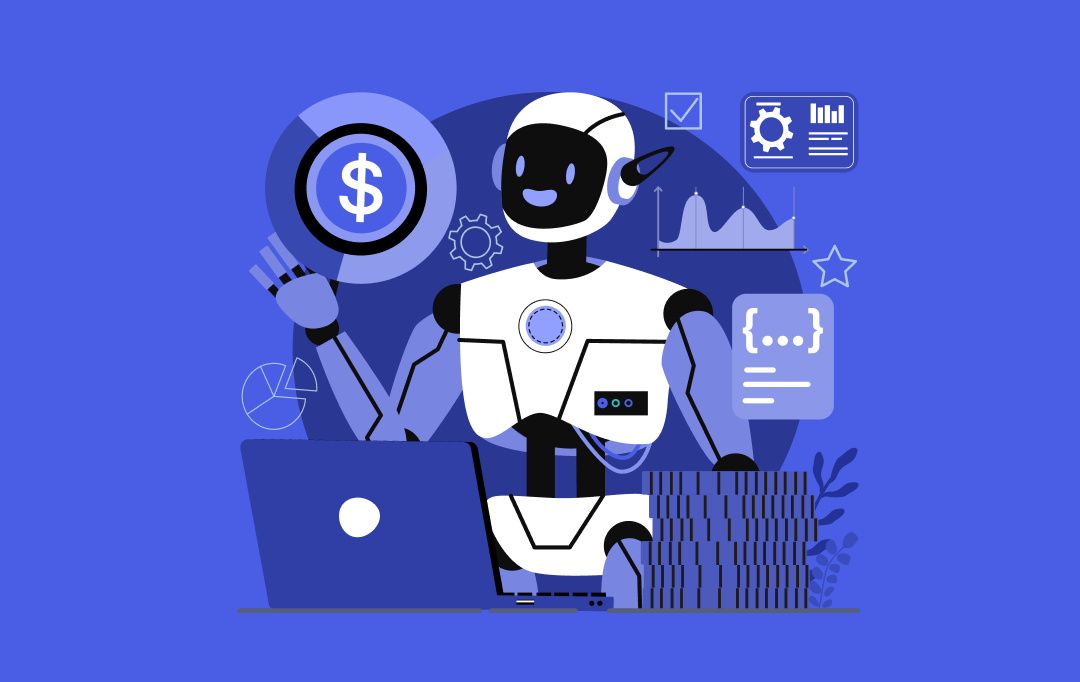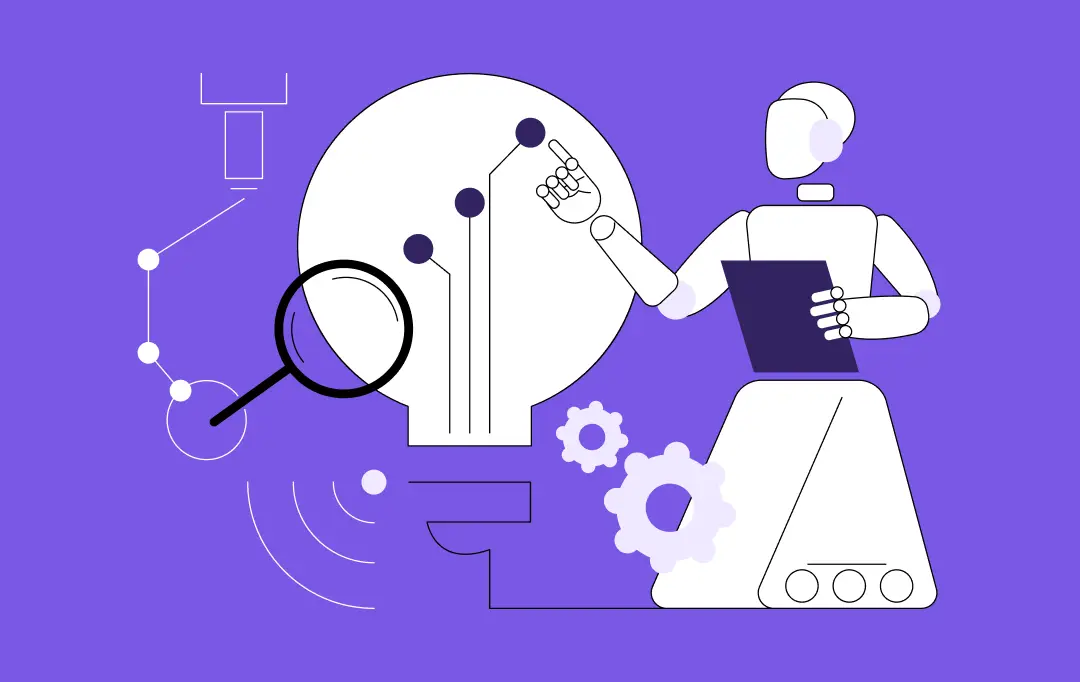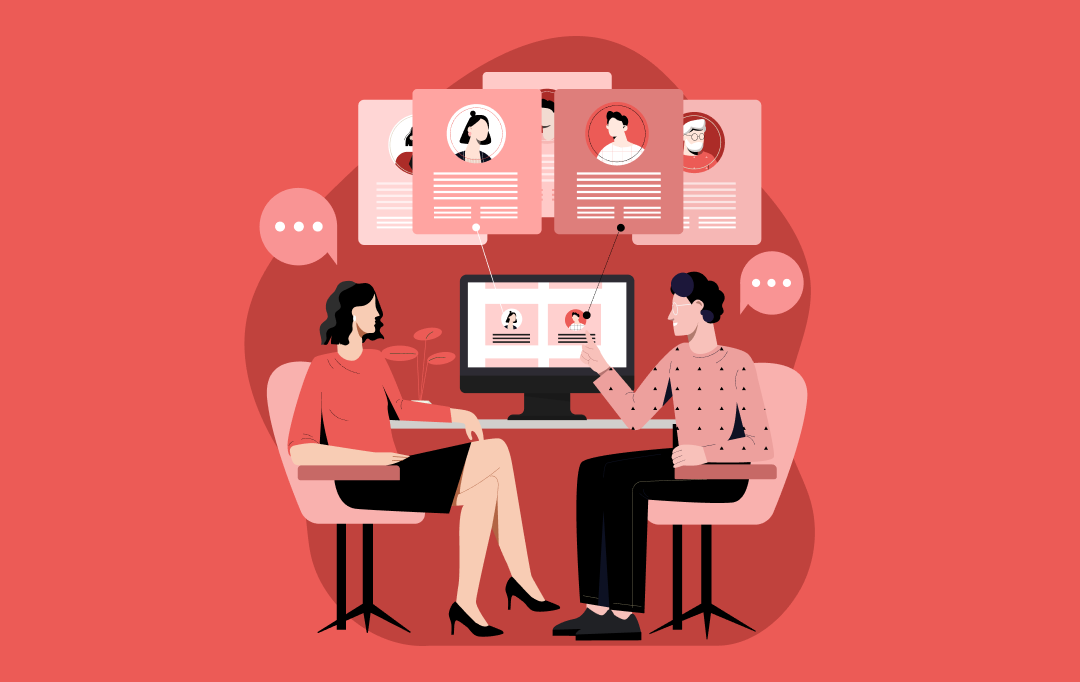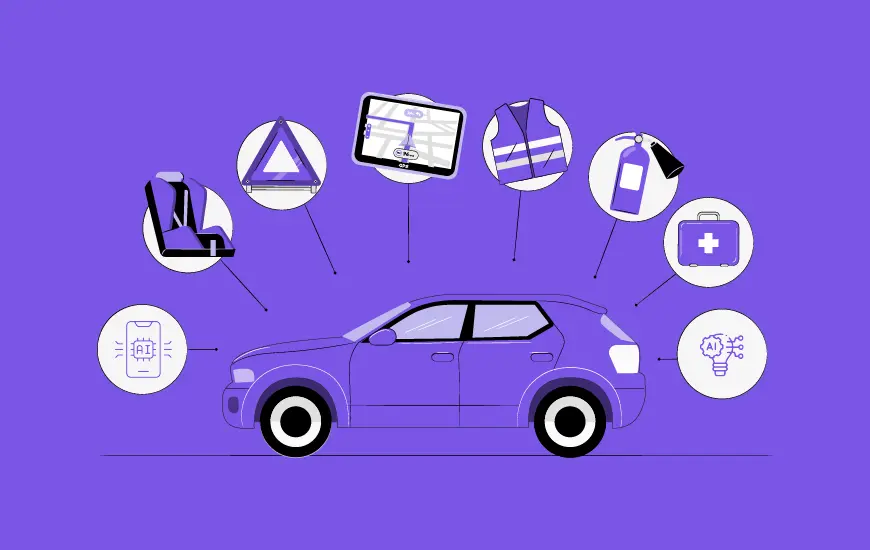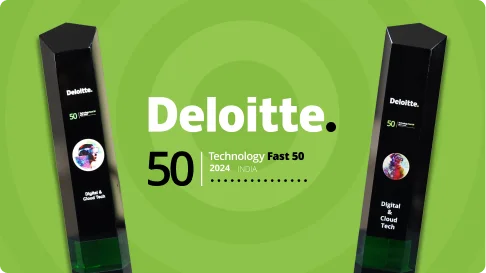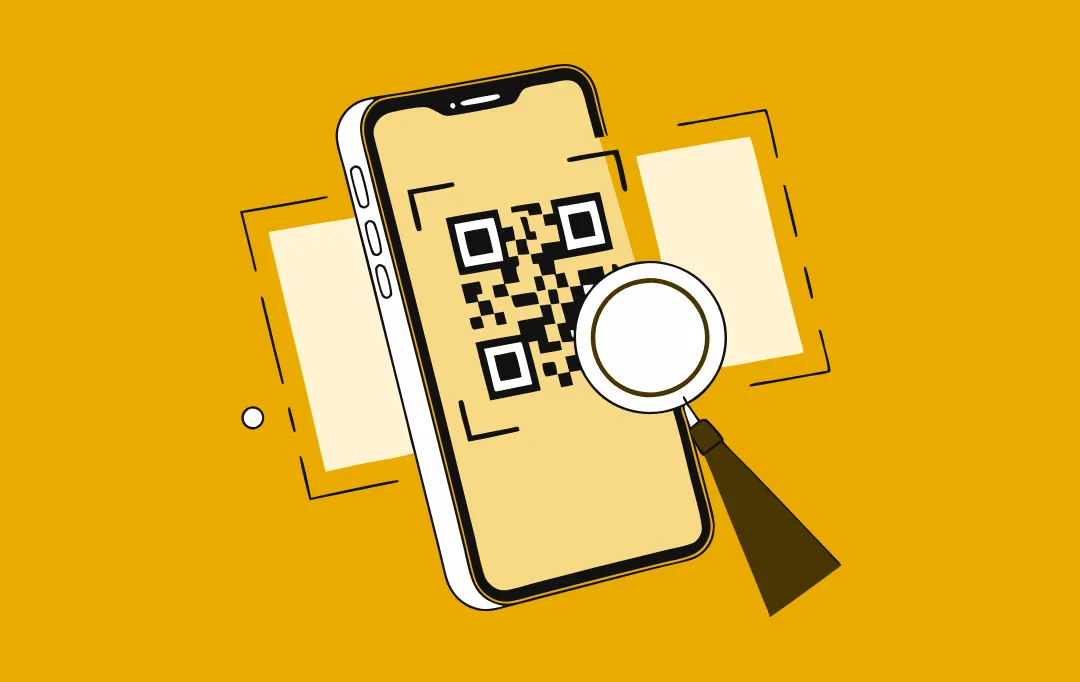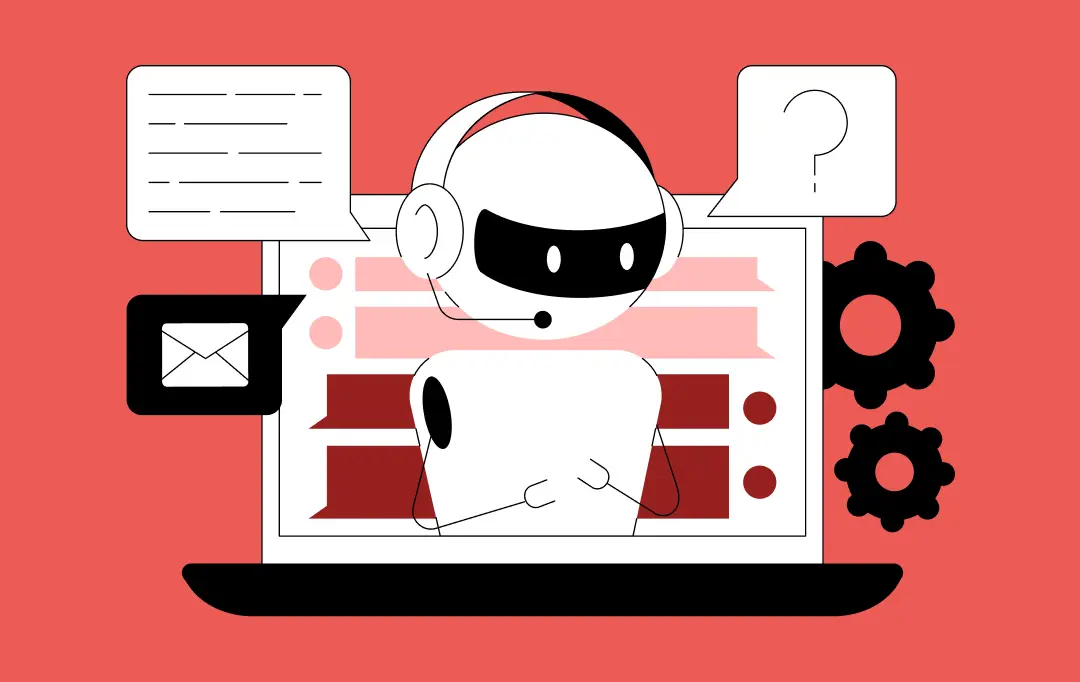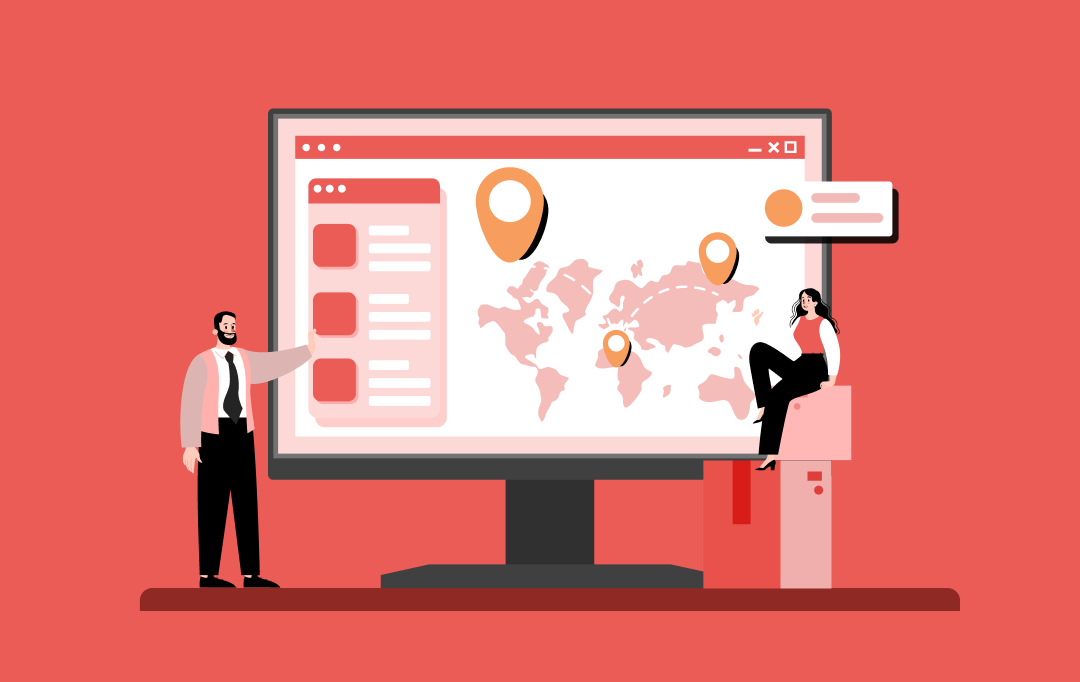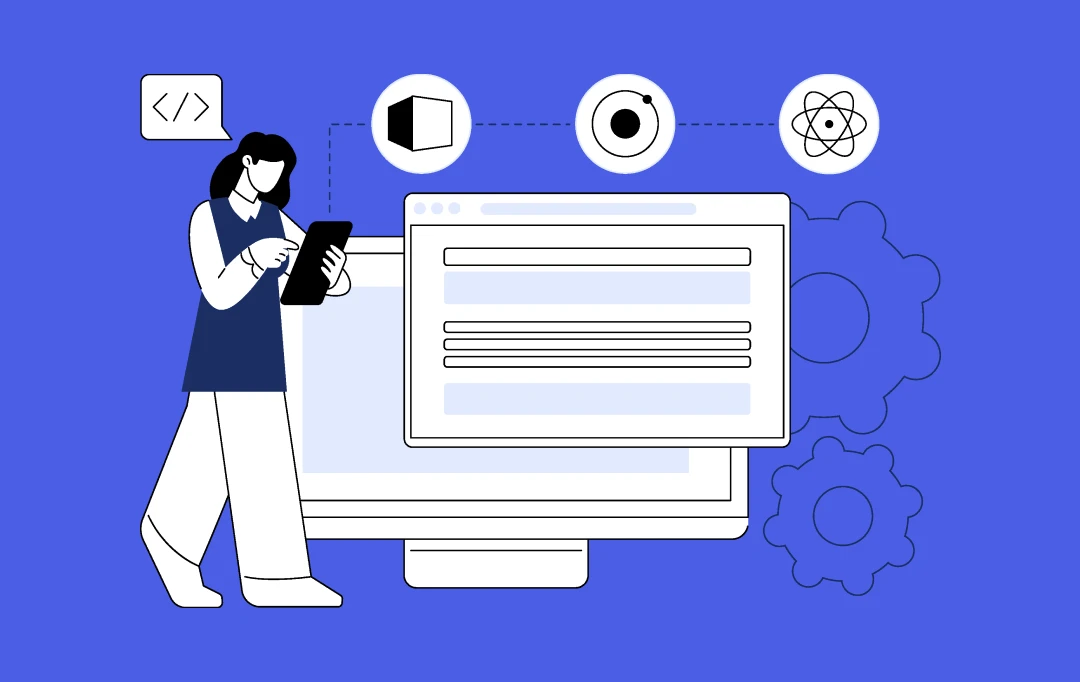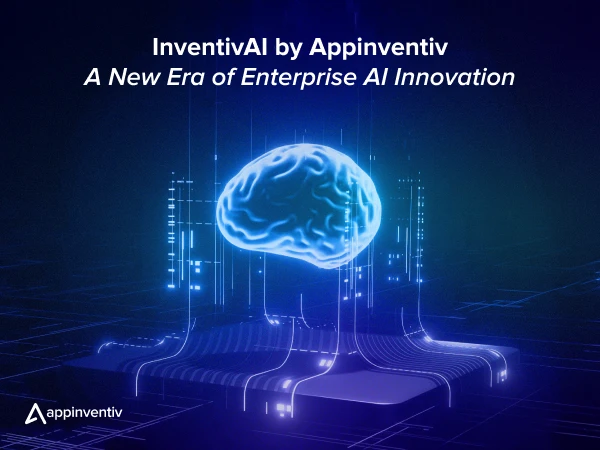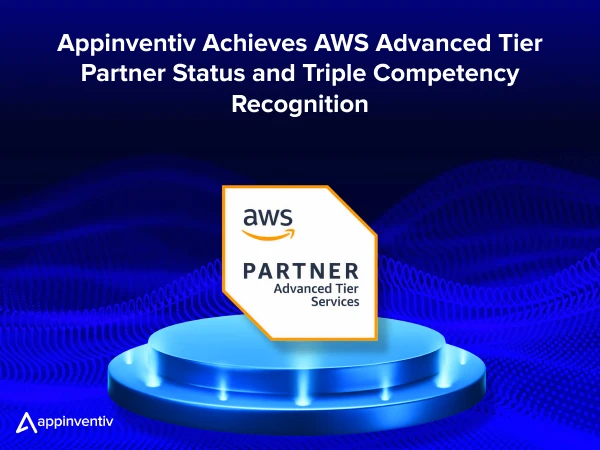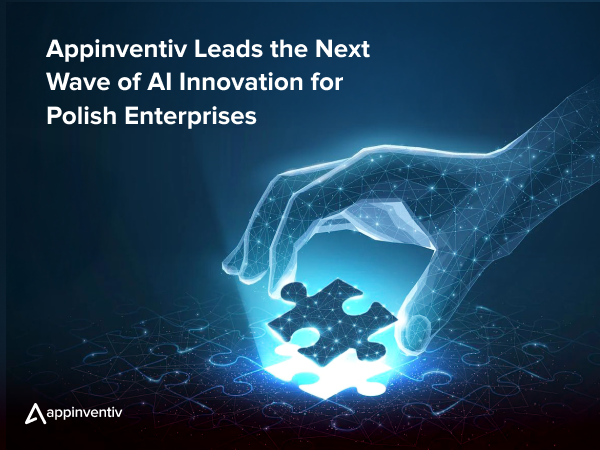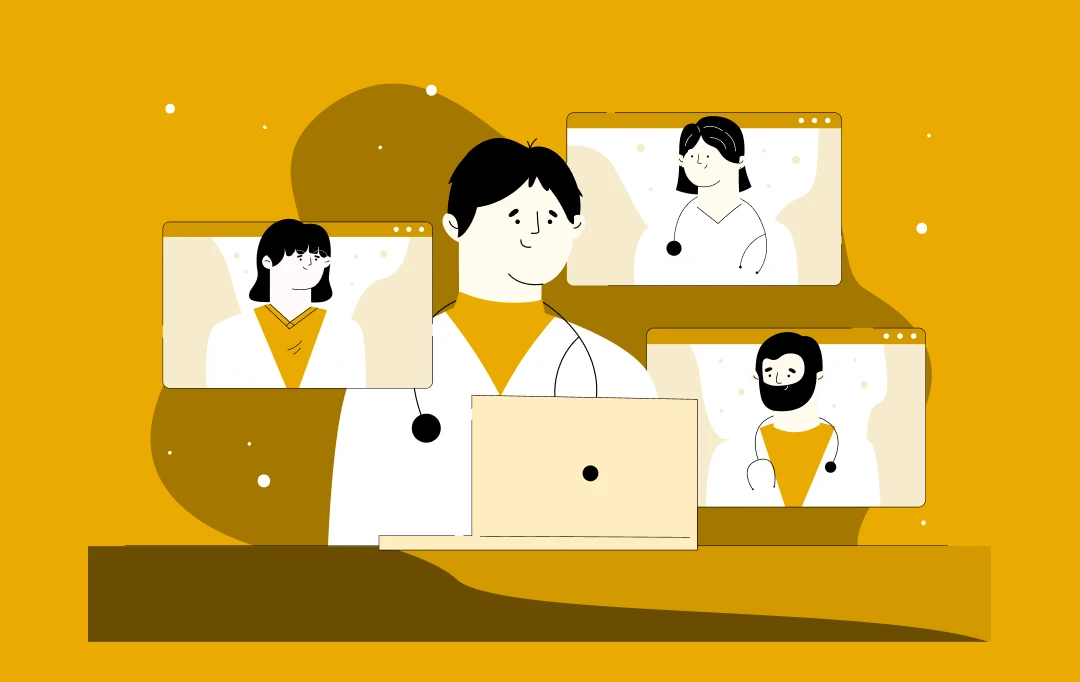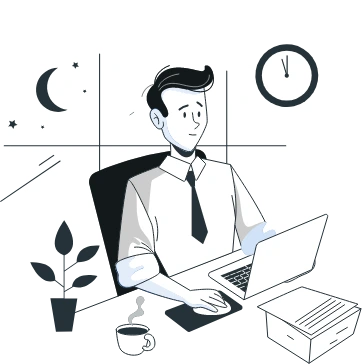- Why Enterprises Are Investing in AI Chatbots
- AI Chatbot Development Cost Breakdown
- 1. Cost by Complexity Level
- 2. Cost by Development Stage
- 3. Cost by Region
- 4. Quick Cost Estimation Formula
- 5. Time and Effort Distribution
- 6. Factors That Can Push Costs Higher
- 7. Comparing AI Chatbot Development Cost Across Use-Cases
- 8. Building an Accurate Estimate
- Factors Influencing AI Chatbot Development Cost
- 1. AI Model and Training
- 2. Design and Experience
- 3. Backend and Infrastructure
- 4. Security and Compliance
- 5. Third-Party Integrations
- 6. Platform and Tech Stack
- 7. Maintenance and Learning
- Detailed Breakdown of AI Chatbot Features and Capabilities
- 1. Basic Features
- 2. Advanced Features
- Feature Impact at a Glance
- 4. Building What Really Matters
- Hidden and Long-Term Costs of AI Chatbot Development
- 1. Maintenance and Upgrades
- 2. Cloud Hosting and Storage
- 3. Model Retraining
- 4. Platform or App Fees
- 5. Promotion and Awareness
- 6. Compliance and Legal Checks
- Smart Strategies to Reduce Your AI Chatbot Development Cost
- How to Develop an AI Chatbot: Step-by-Step Process
- Real Results, Real Impact: How Appinventiv Builds Enterprise-Grade AI Chatbots
- MyExec – AI Business Consultant for SMBs
- Mudra – Budget Management App for Millennials
- Why These Projects Stand Out
- Revenue Model and Monetization Pathways for AI-Driven Chatbots
- Choosing the Right AI Chatbot Development Partner
- Why Building With Appinventiv Makes a Difference
- FAQs
Key takeaways:
- Building an enterprise AI chatbot in 2026 can cost between $40,000 and $400,000 based on complexity, integrations, and model selection.
- AI chatbot development costs are shaped by planning, training data, compliance, and ongoing maintenance not just coding efforts.
- Choosing between pre-trained and custom LLMs heavily impacts both upfront AI chatbot costs and long-term ROI.
- Most enterprises recover their chatbot investment within the first year through reduced support load, faster response times, and higher engagement.
- Smart planning starting with an MVP, using hybrid teams, and tracking development timelines helps maximize value while staying within budget.
A few years ago, chatbots were just basic digital assistants. They answered simple questions and followed a script. Things have changed. Today, they’re powered by artificial intelligence, trained on real data, and smart enough to hold full conversations. Every enterprise now wants to know one thing and that is how much does it cost to build an AI chatbot in 2026?
The truth is, there’s no single number. The AI chatbot development cost can range anywhere between $40,000 and $400,000, depending on what you want your chatbot to do, how intelligent it needs to be, and what technologies you use. For enterprises, understanding the enterprise AI chatbot development service cost helps in comparing vendors and planning long-term investments effectively.
Also it is worth mentioning that the custom AI chatbot development cost will always differ from an off-the-shelf build because every business has its own needs, scale, and user goals.
These new-age chatbots are not limited to chat windows anymore. They use voice, understand context, and even adapt to a user’s mood. According to McKinsey & Company, around 70 percent of large enterprises have already started using AI chat or copilot systems to automate customer communication and internal workflows.
Knowing your enterprise AI chatbot development cost helps you plan better, whether you’re comparing vendors, building in-house, or exploring full chatbot software pricing with ROI estimates. This guide breaks everything down clearly: the AI chatbot development cost in 2026, the hidden factors that raise it, and what you can do to make your investment truly pay off.
It’s your turn to lead that change.
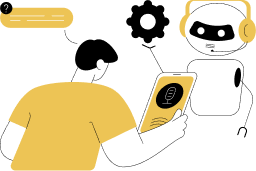
Why Enterprises Are Investing in AI Chatbots
Businesses across industries are treating chatbots as a serious part of their digital strategy
Though, for many, the question isn’t whether to use one but how soon they can get started. The growing interest in enterprise AI chatbot development shows how companies are shifting focus from short-term automation to long-term intelligence. These AI systems can do a lot more than reply. They can analyze tone, understand context, and even suggest solutions before the customer asks.
The real reason behind this shift is simple. Speed and accuracy matter more than ever. Customers want answers right away, and enterprises want to deliver them without burning out their teams. Here’s what’s driving most investments in AI-powered chatbot development today:
- Always available: Chatbots don’t need shifts or days off. They respond instantly, even during peak hours.
- Scale without extra hiring: Once trained, a single AI chatbot can handle thousands of chats simultaneously, making operations lighter and faster.
- Smarter conversations: These tools can read intent and learn from interactions, improving the user experience over time.
- One system, multiple platforms: They connect easily with websites, CRMs, mobile apps, or social channels, keeping communication consistent everywhere.
- Return on investment: The upfront AI chatbot development cost for business is often recovered quickly because of how much time and manpower they save.
A report from Grand View Research predicts the global chatbot market will cross $27.29 billion by 2030, driven largely by enterprise adoption and advancements in natural language understanding. That growth tells its own story, pointing that investing in intelligent chatbots isn’t a trend anymore; it’s a strategic decision.
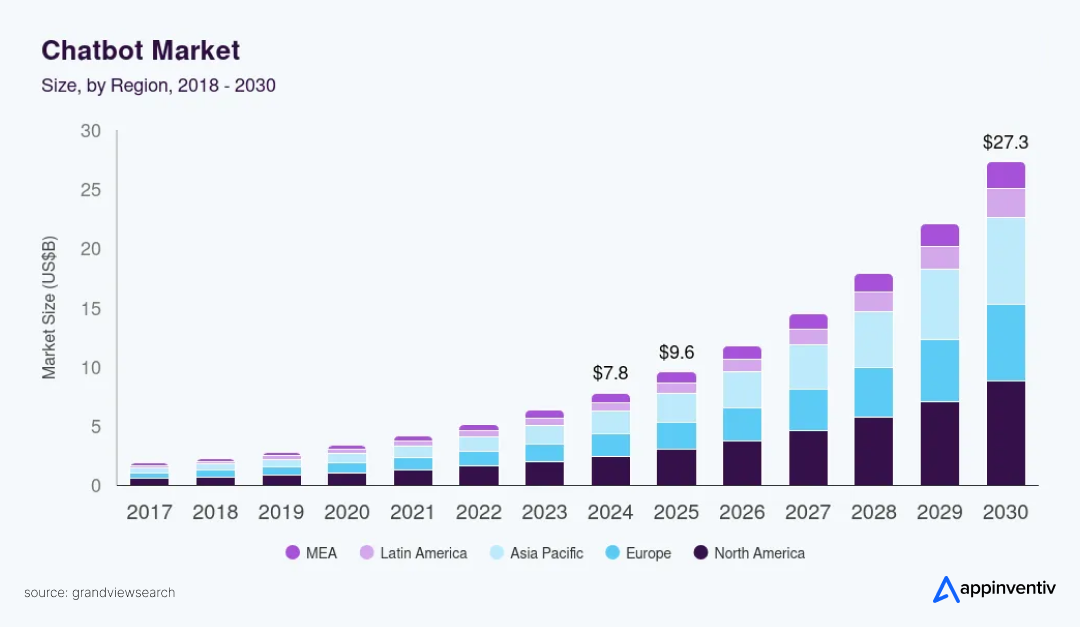
From banks simplifying transactions to healthcare providers assisting patients round the clock, chatbots are quietly becoming part of daily operations. And for most enterprises, understanding the real AI chatbot development cost is the first step toward building that future.
AI Chatbot Development Cost Breakdown
When you ask “how much does it cost to build an AI chatbot?” The real answer isn’t a number, it’s a range shaped by dozens of small decisions. The enterprise AI chatbot development service cost structure depends heavily on complexity and integration depth.
A simple rule-based chatbot development cost might start near $40,000, while a fully-fledged enterprise AI chatbot using LLMs, voice, and advanced analytics can climb above $400,000.
That’s a big gap, but understanding the breakdown helps you see where the money really goes, and which parts of the investment actually drive ROI.
1. Cost by Complexity Level
The more capable the chatbot, the higher the cost. The AI-based chatbot cost depends on the depth of automation and model sophistication. And complexity doesn’t just mean more features, it means deeper integrations, smarter models, and longer training cycles. For example building a chatbot with deep NPL is going to cost more when compared to a basic rule-based chatbot.
| Chatbot Type | Key Capabilities | Estimated Cost | Timeline |
|---|---|---|---|
| Basic (Rule-Based) | Handles FAQs, simple responses, single language | $40K – $80K | 3–4 months |
| Intelligent (NLP-Driven) | Context awareness, sentiment detection, CRM sync | $80K – $200K | 4–7 months |
| Advanced Enterprise Chatbot | Custom LLM, voice support, multi-language, analytics dashboard, workflow automation | $200K – $400K+ | 7–12 months |
Projects with custom models often carry higher LLM-powered chatbot development cost due to data training and testing. And as your chatbot moves from pre-scripted logic to self-learning intelligence, the enterprise AI chatbot development cost rises sharply, so does its long-term value.
2. Cost by Development Stage
Every chatbot follows a journey, and each stage adds its share to the overall bill. Understanding this flow helps plan budgets better and avoid surprises mid-project.
| Development Stage | Description | Average Cost Share |
|---|---|---|
| Planning & Research | Mapping use cases, goals, and KPIs | 10% |
| Conversation Design & UI | Designing tone, flow, and chat experience | 15% |
| AI Model Development | NLP setup, training data, model fine-tuning | 25–30% |
| Backend Development | API integration, database management, cloud setup | 20% |
| Testing & QA | Functionality checks, load testing, bias removal | 10% |
| Deployment & Maintenance | Launch, monitoring, and updates | 10–15% |
A major chunk of the AI chatbot development cost in 2026 goes into model training and backend work. These are the two areas that decide how fast and accurately your chatbot can respond.
3. Cost by Region
Location plays a big role in cost. Building the same chatbot in New York and in Bengaluru can lead to very different budgets.
| Region | Avg. Hourly Rate | Approx. Project Range |
|---|---|---|
| United States | $80 – $150/hr | $100K – $400K |
| Europe | $60 – $120/hr | $80K – $300K |
| UAE / Middle East | $50 – $100/hr | $70K – $250K |
| India | $30 – $60/hr | $40K – $150K |
Many global enterprises today prefer hybrid engagement, in which the strategy is handled by their in-house team, and development outsourced to expert partners in cost-effective regions like India. It’s how they strike a balance between quality, speed, and budget.
4. Quick Cost Estimation Formula
If you’re still at the planning stage, here’s a quick formula that helps visualize cost before you start collecting vendor quotes.
Estimated Cost = (Development Hours × Hourly Rate) + AI Model Fee + Integration Cost + Maintenance Allowance
This simple approach helps estimate the cost to build a chatbot with fair accuracy.
Let’s take an example for more clarity. Suppose your team estimates 2,000 development hours at $60/hour. That’s $120,000 in labor, plus roughly $8,000 for AI model licensing and $12,000 for integrations and maintenance. You’re looking at about $140,000 total.
This simple formula can make early budgeting easier and helps compare custom AI chatbot development costs across agencies before locking in a contract.
5. Time and Effort Distribution
Timeframes depend on project scale. Having a clear roadmap ensures on-time AI chatbot development cost stays within expectations. But most chatbot builds follow a predictable rhythm from idea to deployment.
- Research and Planning: 2–3 weeks
- Design and Flow Building: 3–4 weeks
- AI Model Training: 6–8 weeks
- Backend and API Integration: 6–10 weeks
- Testing and Optimization: 3–4 weeks
- Deployment and Support Setup: 2 weeks
A medium-complexity chatbot usually takes around 5–7 months. A high-end enterprise-grade bot can stretch to 9–12 months, especially when it includes voice and multilingual layers.
6. Factors That Can Push Costs Higher
Two chatbots may look similar on the surface but have very different price tags. These are the usual reasons why:
- AI engine selection: Using GPT-4 or Claude is cheaper to start, but custom LLMs bring better data control.
- Training data preparation: The more curated and industry-specific your dataset, the longer the annotation and testing.
- System integrations: CRM, ERP, and payment integrations add backend load and security checks.
- Regulatory compliance: HIPAA, GDPR, or PDPL frameworks require encryption and audits, increasing the enterprise chatbot development cost.
- Cloud infrastructure: Compute costs vary with providers, it depends on who you choose, as AWS, Azure, and GCP each have their own pricing tiers.
- Voice and multi-language support: Adding voice input or translation models increases AI voice chatbot development cost significantly.
These aren’t just add-ons, they’re what turn a basic chatbot into a true enterprise solution.
7. Comparing AI Chatbot Development Cost Across Use-Cases
Different industries use chatbots for different reasons, and that directly affects cost.
| Use-Case | Chatbot Type | Cost Range |
|---|---|---|
| Customer Support | AI + CRM Integration | $50K – $120K |
| Healthcare Assistant | HIPAA-Compliant, Patient Handling | $100K – $250K |
| Banking Bot | KYC Verification, Transactions | $150K – $300K |
| Internal HR Bot | Workflow and Employee Queries | $60K – $130K |
| E-commerce Bot | Product Discovery, Order Tracking | $80K – $200K |
For example, AI healthcare chatbot development cost tends to be higher because of compliance checks and data privacy requirements. On the other hand, a support or HR chatbot is simpler, cheaper, and quicker to deploy. Each use-case of enterprise AI chatbot
Development cost varies by compliance and user interaction complexity.
8. Building an Accurate Estimate
Creating an accurate cost estimate is less about spreadsheets and more about clarity. A well-planned estimate helps teams stay on budget and aligned with business outcomes.
Start by defining the goal. This first step is critical when calculating the cost to develop an enterprise AI chatbot, since every feature affects hours and pricing.
Figure out the purpose of your chatbot Is it meant to reduce support tickets, collect leads, or help employees find information? The clearer your objective, the easier it is to forecast the right AI chatbot development cost for business.
Next, list essential features and rank them. Separate must-haves like user authentication or CRM sync from optional add-ons such as analytics dashboards or voice input. This helps create a realistic MVP roadmap before scaling.
Identify every integration early. Whether it’s payment gateways, scheduling tools, or customer databases, each connection adds complexity and time.
Don’t forget about maintenance and retraining. After launch, chatbots continue learning, adapting to user behavior, and evolving with updates. That usually adds another 10–15% of annual cost.
Finally, consider starting with a proof of concept (PoC). It’s a smaller version of your idea, built fast to validate workflows and user experience. A good PoC can reveal gaps before you commit to full-scale development, saving both time and money.
Companies that invest in this early clarity often discover their actual enterprise chatbot pricing turns out lower than expected because they’re not paying to fix mistakes later.
At this point, you should have a clear picture of where every dollar in your cost of AI chatbot development goes, from model licensing to compliance and backend setup.
In the next section, we’ll look at the factors of enterprise AI chatbot development cost in even greater detail, and how to optimize them for stronger ROI.
Factors Influencing AI Chatbot Development Cost
No two chatbots cost the same. That’s why the cost to build chatbot changes with the goal, scale, and tech choices behind it. These are the main factors that shape your AI chatbot development cost for business.
1. AI Model and Training
The smarter the chatbot, the higher the price.
- Pre-trained models like GPT-4 are cheaper to use.
- Custom AI models need domain data and training time, which increases the LLM-powered chatbot development cost.
The custom AI chatbot development cost rises when your chatbot learns from specialized business data.
2. Design and Experience
Looks matter here.
- A plain text chatbot is quick to build.
- Adding visuals, voice, or multi-language support adds design time and cost.
Great design improves retention and makes the extra expense worth it.
3. Backend and Infrastructure
Your chatbot runs on code, servers, and APIs.
- More AI integrations in business application mean more hours.
- Using secure, scalable cloud systems also affects enterprise AI chatbot development cost.
4. Security and Compliance
For sectors like healthcare and banking, compliance drives complexity.
- Meeting GDPR, HIPAA, or PDPL can raise budgets by 15–25%.
- Encryption and data audit setups take extra time.
5. Third-Party Integrations
The more platforms you connect, the more development effort you need.
- CRMs, ERPs, or payment tools add integration fees.
- Some APIs charge per use, creating ongoing costs.
6. Platform and Tech Stack
A chatbot made for one platform costs less than an omnichannel setup.
- Web-only builds are simple.
- Deploying across WhatsApp, Slack, and mobile apps expands scope.
Voice, NLP, and LLM frameworks raise the AI-powered chatbot development cost but improve long-term performance.
7. Maintenance and Learning
Work doesn’t end at launch.
- Regular retraining, updates, and scaling cost 10–15% yearly.
- Smart monitoring ensures the bot keeps learning and performing better over time.
Each of these factors of enterprise AI chatbot development cost plays a role in shaping your final budget. The key is to balance ambition with practicality by investing more where it truly adds value.
Detailed Breakdown of AI Chatbot Features and Capabilities
The features you choose decide how smart your chatbot becomes, and how much it costs to build. A chatbot with simple replies will always cost less than one that understands tone, context, and intent.
1. Basic Features
Every chatbot starts with the essentials.
These are the features that make it functional, not fancy.
- User login or authentication: Keeps conversations secure and personal.
- Predefined replies: Perfect for FAQs or simple instructions. This keeps the rule-based chatbot development cost practical for small businesses.
- Chat history: Lets users revisit old conversations when needed.
- Push notifications: Keeps customers engaged even when they leave the chat.
Most chatbot software pricing plans already include these. Think of them as the building blocks before intelligence kicks in.
2. Advanced Features
Once you have the basics, the real magic begins.
This is where automation turns into experience.
- Natural language understanding (NLU): Reads tone, intent, and mood instead of just words.
- Voice and multilingual chat: Great for global brands, though it increases AI voice chatbot development cost.
- Analytics dashboard: Tracks conversation quality and customer satisfaction.
- CRM or ERP integration: Pulls real-time data for more personalized responses.
- Custom LLM model integration: Trains your chatbot on internal data for deeper context. This increases the cost of custom chatbot but delivers unmatched relevance and accuracy.
These upgrades make the enterprise chatbot pricing go up, but they also make the system smarter, faster, and more human in its responses.
Feature Impact at a Glance
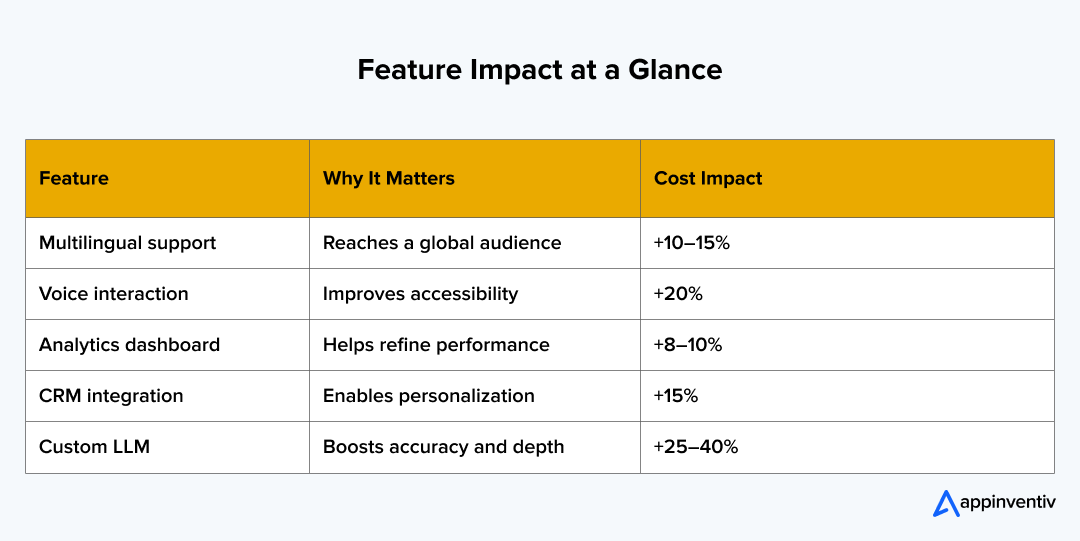
4. Building What Really Matters
Not every feature adds value right away.
The smart approach is to launch small, measure real user behavior, and then expand.
A well-designed MVP with focused features often performs better and costs less than a loaded chatbot that users find overwhelming.
Choose functions that make life easier for customers, not just fancier for demos. That’s how you keep your AI-powered chatbot development cost justified and results-driven.
Hidden and Long-Term Costs of AI Chatbot Development
Most teams plan for what it takes to build a chatbot, not what it takes to keep it running. But once it’s live, real work begins. A good chatbot is like any other digital product, it needs care, updates, and a steady budget to stay useful.
1. Maintenance and Upgrades
No chatbot stays perfect after launch. Bugs appear, flows break, and user behavior changes.
Keeping things smooth means constant tuning, fixing logic gaps, refining responses, and rolling out updates. On average, expect to spend 10–15 percent of the total AI chatbot development cost each year on upkeep.
Think of it as preventive care. Small updates now save you from expensive rebuilds later.
2. Cloud Hosting and Storage
Chatbots live in the cloud. The more people use them, the more server power they need. Cloud usage contributes a large share to total chatbot software development cost over time.
Your hosting bill depends on how much data the bot processes and which provider you choose. Is it AWS, Azure, or Google Cloud, as all of their price usage is different.
It’s wise to track this monthly; cloud fees often rise quietly as traffic grows.
To get a deeper insight, read our detailed blog on how to choose the best cloud solution for business needs.
3. Model Retraining
An AI chatbot learns from experience, but only if you retrain it.
Over time, new queries appear, products change, and language shifts. Updating your model with fresh data keeps accuracy high and tone consistent. For custom AI chatbot development, this retraining becomes an ongoing cost rather than a one-time job.
4. Platform or App Fees
If your chatbot runs on WhatsApp, Slack, or similar channels, expect message-based or user-based charges. They look small at first but can multiply once adoption scales.
Many companies only notice these numbers after the first full quarter of usage.
5. Promotion and Awareness
Launching a chatbot quietly rarely works.
A small marketing push like banners, emails, or social mentions helps people find and use it. Promotion doesn’t cost much individually but still adds up over the year.
Real ROI comes only when people actually engage with your chatbot.
6. Compliance and Legal Checks
Industries like finance and healthcare require constant security validation. Renewing GDPR, HIPAA, or PDPL compliance means audits, paperwork, and sometimes extra encryption.
It’s an invisible cost, but it protects the one thing you can’t buy back, which is customer trust.
When you plan for these ongoing expenses from the start, your enterprise AI chatbot development cost becomes predictable. Instead of sudden bills or downtime, you’ll have a chatbot that keeps improving quietly in the background just in the way good technology should.
Smart Strategies to Reduce Your AI Chatbot Development Cost
Building a chatbot doesn’t have to burn through your budget. Small, smart steps make a big difference.
- Start small. Launch an MVP with only the key features. Test it, learn from users, then scale.
- Use pre-trained models. GPT or open-source tools work well early on and cost far less than custom AI builds. This alone can bring down the AI-based chatbot cost without losing key functionality.
- Focus on what matters. Add only the features that solve real problems. The fancy stuff can wait.
- Outsource wisely. Working with skilled teams in affordable regions helps cut costs without cutting quality.
- Think ahead. Plan for growth now, so you don’t rebuild everything later.
Good planning keeps your AI chatbot development cost efficient and your results strong. Spend where it counts and on impact, not on extras.
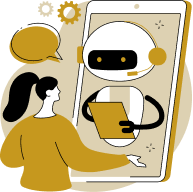
How to Develop an AI Chatbot: Step-by-Step Process
Building a chatbot isn’t just about AI models or code. It’s about knowing what you want it to do and keeping things simple from the start.
- Set the goal: Decide what the chatbot should achieve, should it offer faster support, better lead capture, or easier service access. A clear goal keeps the AI chatbot development cost focused.
- Choose the platform: Start where your users are. WhatsApp, website, or app, based on where they spend most of their time, pick one, learn, then scale.
- Plan the conversation: Write how people will talk to it, greetings, help requests, or errors. Make it sound clear and natural.
- Pick the tech: Use a pre-trained model if you need speed or a custom one for more control. Balance performance with cost.
- Build and connect: Integrate it with your CRM or support tools so it gives real answers, not just scripted ones.
- Test and launch: Try it with real people. Fix gaps, polish responses, and keep improving after launch.
The best chatbots don’t just go live, they evolve. Every update makes your investment in enterprise chatbot development more valuable over time.
Real Results, Real Impact: How Appinventiv Builds Enterprise-Grade AI Chatbots
At Appinventiv, we don’t just build chatbots, we build intelligent systems that solve real business problems and create measurable value. Here are two examples that show what that looks like in action.
MyExec – AI Business Consultant for SMBs
Challenge: Small and mid-sized businesses often struggle to afford strategic consultants. The goal of MyExec was to change that by building an AI-driven business advisor that could read documents, analyze data, and deliver actionable insights through a chat interface.
Our Solution: For MyExec, we created a multi-agent RAG (Retrieval-Augmented Generation) system that uses enterprise data to answer complex business questions contextually and accurately. The chatbot acts like a 24/7 consultant, who is always ready with performance summaries and growth suggestions.

Highlights:
- Development cost range: USD 50,000 – 300,000 (based on scope and integrations)
- Delivery timeline: 5–7 months for the MVP, 9–14 months for the complete multi-agent version
- Core value: Helped SMBs access strategic advice without hiring a full consulting team
The result is a scalable, intelligent chatbot that brings AI-led decision-making to businesses that once couldn’t afford it.
Mudra – Budget Management App for Millennials
Challenge: Managing money isn’t fun for most people, especially for young users juggling multiple expenses. The idea behind Mudra was to make personal finance effortless and conversational.
Our Solution: For Mudra, we designed a budgeting app where the chatbot is the interface itself, offering friendly, fast, and intuitive guidance. Built using Google Dialogflow, Mudra simplifies expense tracking, reminders, and saving tips through chat.
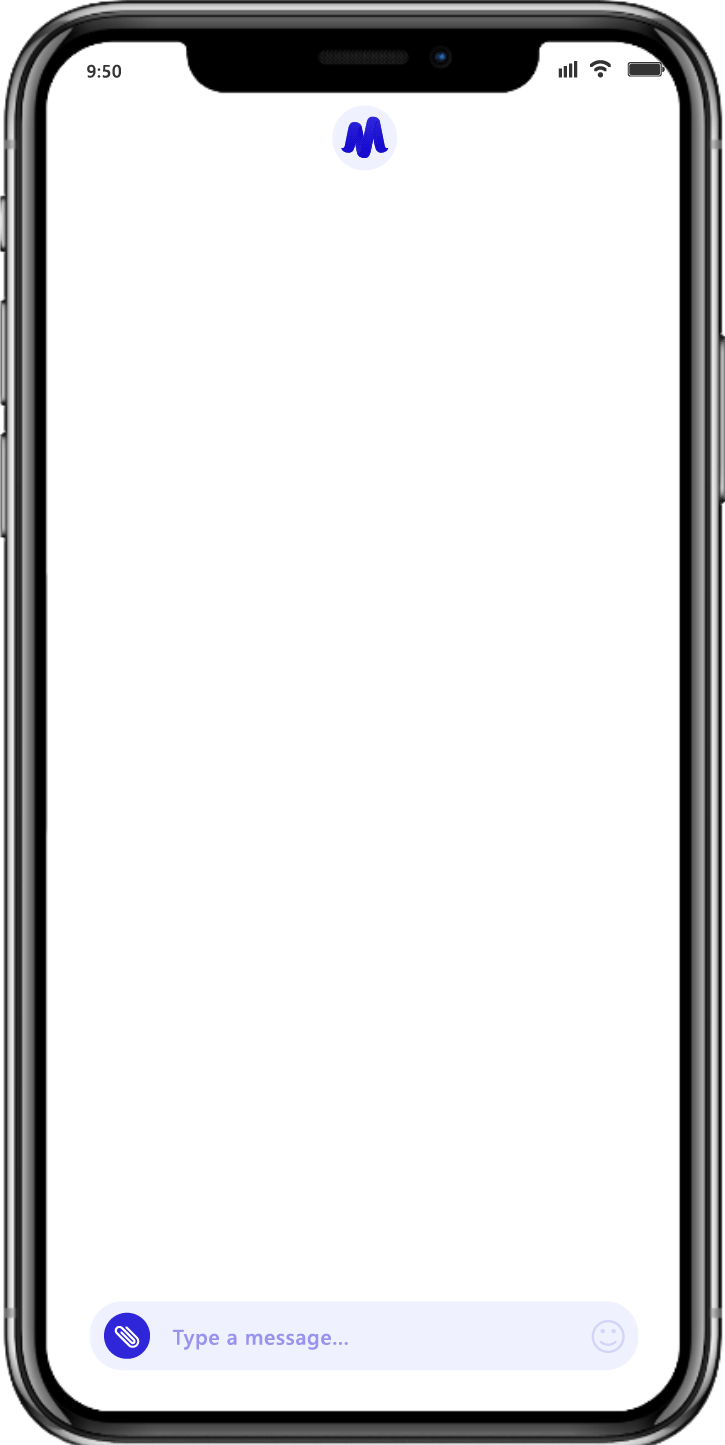
Highlights:
- Development timeline: 6 months from design to launch
- Global rollout: Deployed in 12+ countries at launch
- Impact: Turned routine expense management into an engaging experience for a digital-first audience
Mudra shows how conversational design can turn something as dry as budgeting into a daily habit.
Why These Projects Stand Out
Both solutions prove what we believe and that is the right mix of AI, design, and strategy can turn any conversation into business value. From enterprise analytics to personal finance, Appinventiv’s approach balances innovation with efficiency, helping clients get the most out of their AI chatbot development cost.
Revenue Model and Monetization Pathways for AI-Driven Chatbots
A chatbot that works well doesn’t just cut costs, but it also creates new ways for a business to earn. When viewed holistically, AI chatbot cost often turns into a profitable long-term investment. With the right setup, it can boost sales, attract leads, and turn routine conversations into measurable revenue.
Here’s how most organizations generate returns from their chatbot systems:
- Lead Generation and Qualification
Chatbots capture user details in real time, filter genuine leads, and hand them directly to the sales team. This helps in keeping the sales funnel active 24/7. - Product Recommendations and Upselling
By analyzing user behavior and purchase history, AI chatbots suggest relevant products or upgrades, increasing order value without human input. - In-Chat Payments
Integrated payment gateways allow users to buy, renew, or subscribe without leaving the chat window, offering a smooth path from interest to transaction. - Subscription-Based Access
Some businesses introduce paid tiers for advanced chatbot features, analytics, or premium support. It’s a simple model that adds recurring revenue. This model also shows how flexible custom chatbot pricing can adapt to different industries. - Advertising and Partnerships
Chatbots with large user bases can partner with third-party services for promotions or sponsored recommendations, turning engagement into ad revenue.
When planned well, the AI Chatbot Development Cost isn’t an expense, instead results in an investment that pays back through automation, conversions, and recurring income.
A chatbot should do more than talk. It should sell, learn, and grow, quietly supporting your team efforts, driving revenue in the background while improving customer experience on the surface.
Choosing the Right AI Chatbot Development Partner
Finding the right people to build your chatbot is a big decision. It’s not just about the code, it’s about working with a team that understands what your business needs and what your users expect.
Here’s what to look for before you choose:
- Real, hands-on experience
Check if they’ve actually built AI chatbots that are live and working. Teams with experience in NLP and LLMs know what can go wrong and how to fix it fast. That kind of understanding keeps your AI Chatbot Development Cost practical and predictable. - A curious mindset
The right partner doesn’t jump straight to development. They’ll ask questions about your customers, goals, and what “success” should look like. A curious team builds smarter, not just faster. - Full-cycle ownership
Try to work with one team that handles everything, from design to launch to updates. It saves time and prevents confusion later. - Strong data ethics
Chatbots process sensitive information. Make sure the team knows how to protect it and follows global data laws like GDPR or HIPAA. As they are essential to have. - Clear communication and pricing
Teams with structured delivery models help maintain on-time AI chatbot development cost without delays. So, ask for a full breakdown of scope, timeline, and cost before you begin. Good partners don’t hide details or add surprise charges halfway through.
A chatbot isn’t a one-time build. It needs people who stay involved in improving, retraining, and growing the product as your business evolves.
The best partners don’t just build software. They build relationships.

Why Building With Appinventiv Makes a Difference
A chatbot is more than a piece of software. It’s a quiet extension of your team, one that listens, learns, and helps your business run smoother. When it’s done right, it doesn’t just answer questions; it builds trust.
At Appinventiv, that’s the mindset behind everything we create. Our chatbot development services focus on understanding your business first, then using technology to solve real problems. We care as much about tone and flow as we do about code, because that’s what makes the experience feel human.
Over time, the numbers speak for themselves. Brands that invest in smart, well-built chatbots often recover their AI Chatbot Development Cost faster than expected. And this is not because they save a few hours of work, but because they transform how people engage with them. Conversations become smoother. Customers stay longer. Teams get time back.
We’ve seen it again and again: when you build with clarity and care, technology becomes invisible, and what remains is connection.
Let’s build the next conversation that transforms your business.
FAQs
Q. How much does it cost to build a chatbot?
A. It really depends on what you’re building. A simple chatbot that handles basic queries can start around $40,000, while an advanced one that uses AI, voice, and analytics can go beyond $400,000. The features, integrations, and use cases decide most of the cost.
Q. How much does it cost to build an AI chatbot software?
A. AI chatbots are more complex because they learn and adapt. On average, building one can cost anywhere between $80,000 and $300,000, depending on how intelligent you want it to be and how much custom data training it needs.
Q. How can Appinventiv help with AI chatbot development and pricing?
A. Appinventiv helps businesses build chatbots that fit their goals and budget. The focus is always on making sure every part, from planning to launch delivers value. Their approach keeps costs predictable while ensuring quality and scalability.
Q. How much will Enterprise AI Chatbot Development Cost in 2026?
A. By 2026, most enterprise-grade chatbots will likely fall between $100,000 and $400,000, depending on how advanced they are. Complex systems that include AI-driven analytics, multilingual support, or strong compliance layers tend to be on the higher side.
Q. How do enterprise chatbots create business value?
A. They cut down response time, reduce dependency on manual teams, and provide consistent 24/7 support. Over time, they help businesses lower costs and improve customer satisfaction and offers the kind of long-term value that adds up quietly.
Q. What factors affect chatbot development cost?
A. Things like complexity, AI model type, integrations, backend setup, and design quality all play a part. Where the chatbot is built also matters, things like regional pricing can make a big difference in the total budget.


- In just 2 mins you will get a response
- Your idea is 100% protected by our Non Disclosure Agreement.
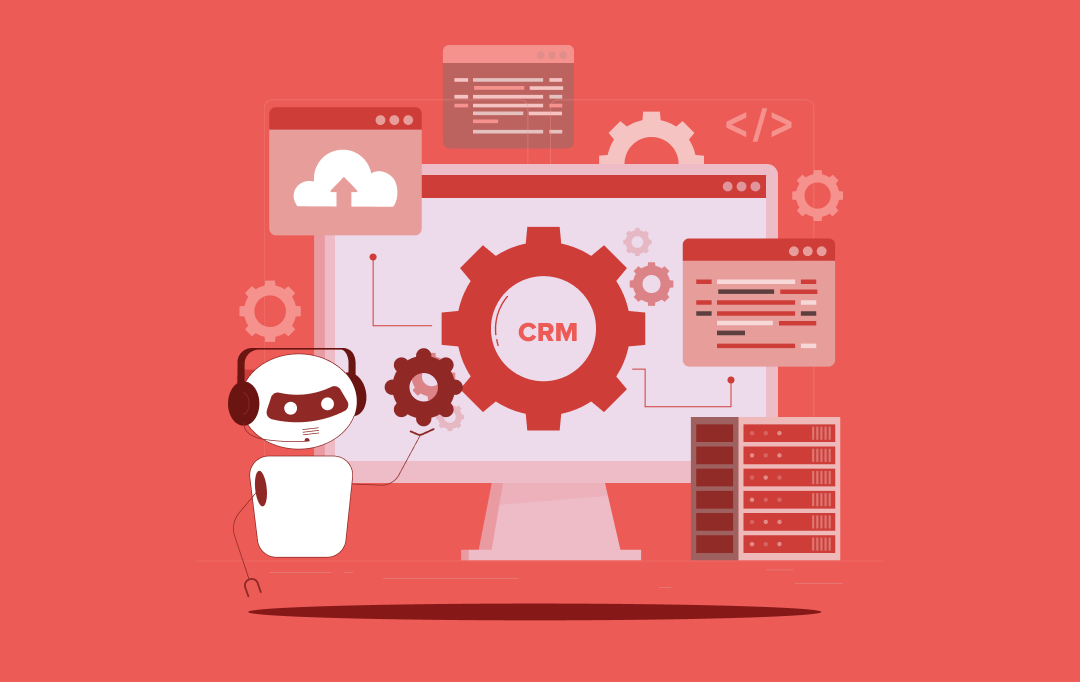
Chatbot Integration With CRM - Benefits, Process, Features, Costs
Key takeaways: Integrating chatbots with your CRM automates routine tasks, delivers instant, personalized responses, and frees up human agents for complex issues, leading to faster resolutions and higher customer satisfaction. Every chatbot interaction is logged in the CRM, creating a unified customer view and generating actionable analytics that help refine marketing, sales, and support strategies.…
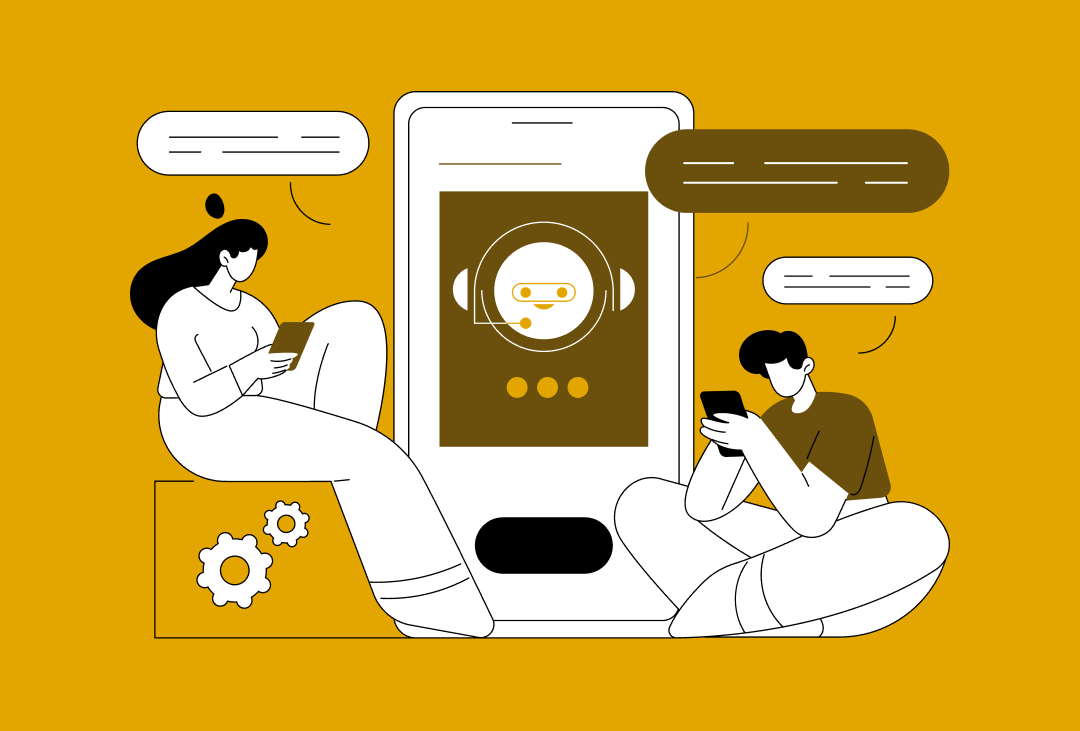
10 Ways Wearable Chatbots Are Enhancing Daily Life: Real Use Cases
Key takeaways: Enhanced User Interaction: Wearable AI chatbots enable hands-free, real-time, context-aware communication, driving user engagement and productivity. Proactive Health Monitoring: Continuous health tracking and personalized insights empower users to manage wellness effectively. Predictive AI: Wearables anticipate user needs with data-driven, contextual responses, improving customer experience. Smart Ecosystem Integration: Seamless integration with smart environments streamlines…
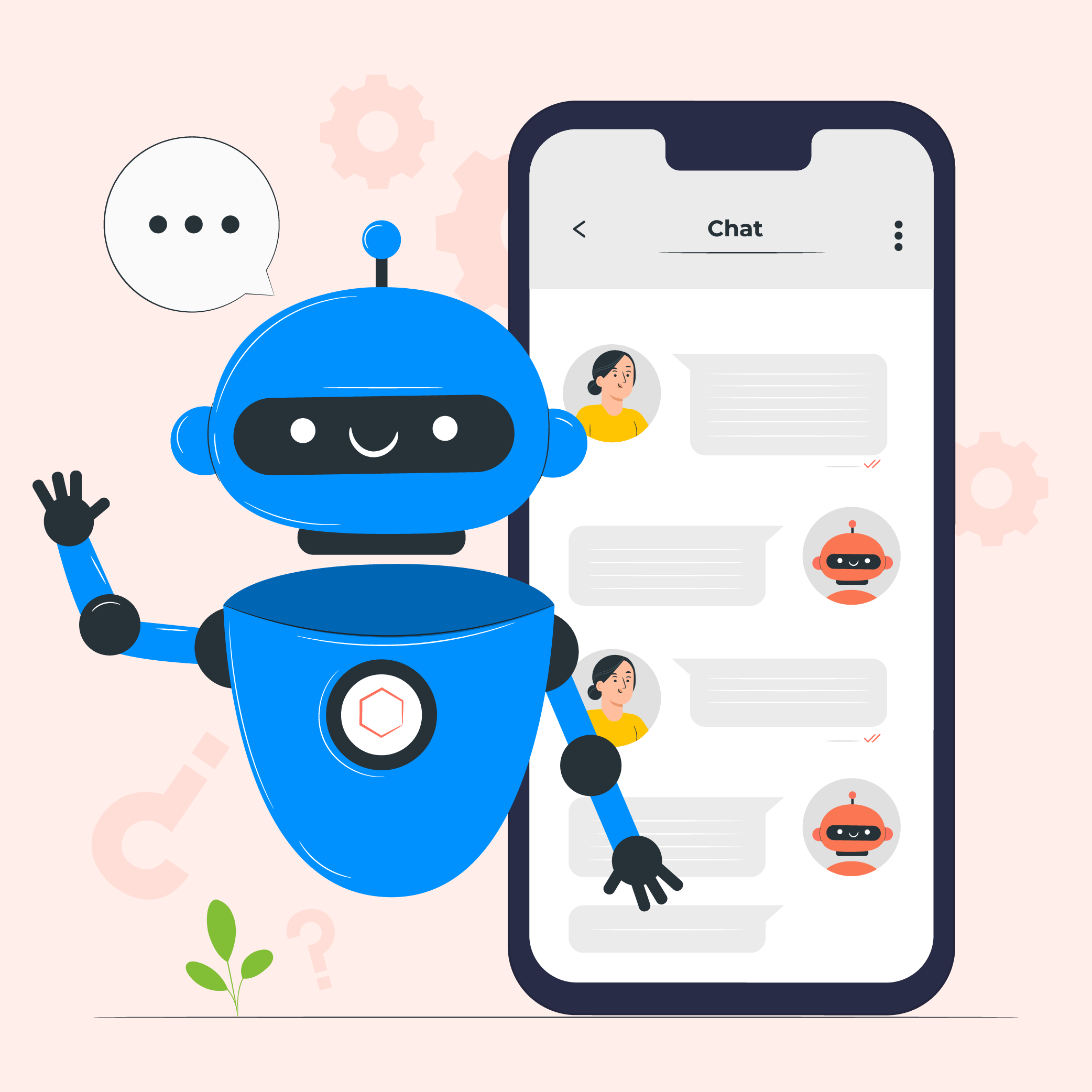
How to Build A Chatbot with Deep NLP?
Earlier,chatbots used to be a nice gimmick with no real benefit but just another digital machine to experiment with. However, they have evolved into an indispensable tool in the corporate world with every passing year. Developing and maintaining a chatbot is, of course, a time, effort and money draining job. Yet, compelling businesses, new and…
